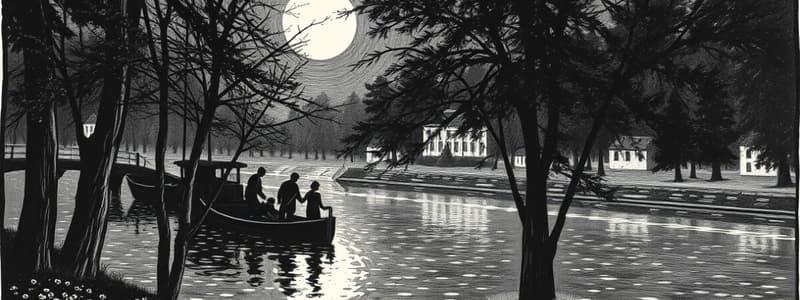Podcast
Questions and Answers
What is printmaking?
What is printmaking?
An artistic process based on the principle of transferring images from a matrix onto another surface, most often paper or fabric.
Which of the following are traditional printmaking techniques? (Select all that apply)
Which of the following are traditional printmaking techniques? (Select all that apply)
- Woodcut (correct)
- Engraving (correct)
- Lithography (correct)
- Screenprinting
A matrix for printmaking can only be made from wood.
A matrix for printmaking can only be made from wood.
False (B)
What materials can a matrix be made from?
What materials can a matrix be made from?
What is a key benefit of printmaking?
What is a key benefit of printmaking?
What happens to the design when printed from a woodcut matrix?
What happens to the design when printed from a woodcut matrix?
What is the ideal thickness for a woodblock used in woodcut printmaking?
What is the ideal thickness for a woodblock used in woodcut printmaking?
What tool is typically used in engraving to incise lines into a metal plate?
What tool is typically used in engraving to incise lines into a metal plate?
Flashcards are hidden until you start studying
Study Notes
Overview of Printmaking
- Printmaking is the artistic process of transferring images from a matrix to another surface, commonly paper or fabric.
- Traditional techniques include woodcut, etching, engraving, and lithography, while modern methods like screenprinting have emerged.
- A matrix, which can be wooden, metal, or glass, serves as a template.
- The design is formed on the matrix through various tools or chemicals and is inked to create prints.
- Controlled pressure, often via a printing press, is required for transferring the design to the printing surface.
- Printmaking allows for multiple impressions from a single matrix, except in monotype.
Different Printmaking Techniques
- Woodcut
- Engraving
- Etching
- Lithography
- Screenprinting
Woodcuts
- The oldest form of printmaking; involves carving a design into a wooden block.
- Raised areas receive ink while recessed areas remain blank in the final print.
- The size of the block affects the image's dimensions and is limited by the printing press size, often requiring multiple blocks for large prints.
- Smaller blocks are advantageous as they are less prone to cracking; ideal thickness is around one inch (2.54 cm).
- Design preparation methods include drawing directly onto the block, pasting a sketch, or transferring design via chalk or graphite.
- Professional block cutters utilize chisels, gouges, or knives for precise carving.
- The block is evenly inked using a dauber or roller, ensuring ink does not spill into the recesses.
- Final prints display the woodcut design in reverse compared to the original block.
Engraving
- Engraving is an intaglio process, where lines are incised into a metal plate (copper or zinc) to hold ink.
- The metal plate is polished to eliminate scratches and imperfections, ensuring only intentional lines are printed.
- A burin, a sharp tool with a bevelled diamond-shaped tip, is used for cutting compositions into the plate.
- The printmaker holds the burin by placing the wooden handle against the palm while gripping the shaft for precision.
Studying That Suits You
Use AI to generate personalized quizzes and flashcards to suit your learning preferences.



